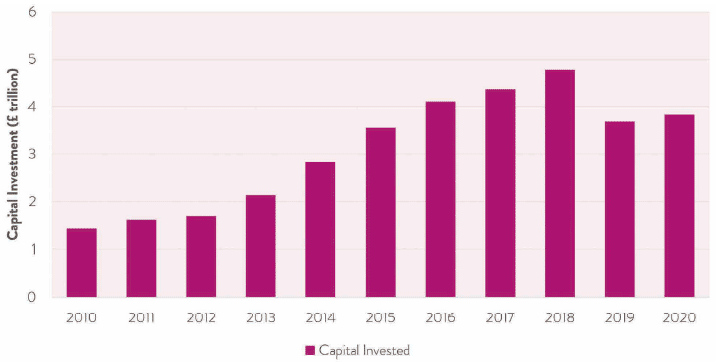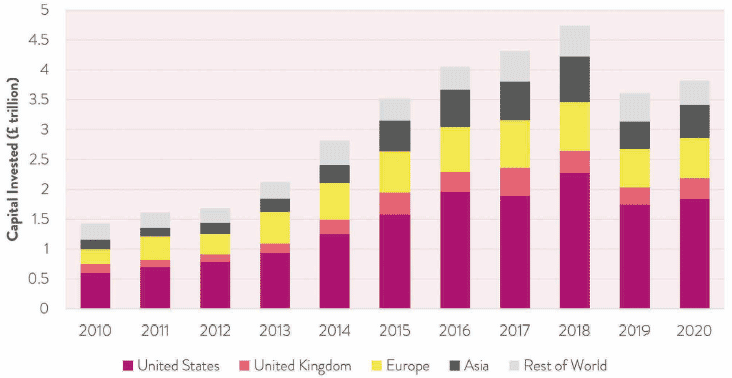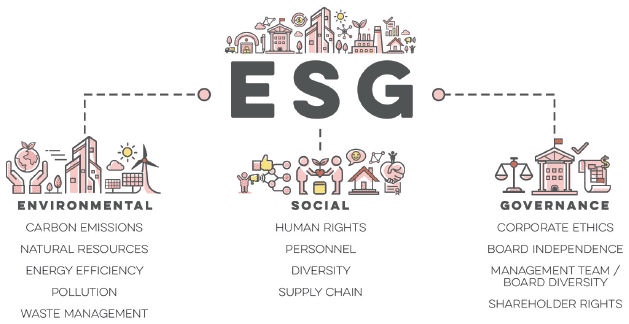Investing with Purpose: global capital investment plan
Plan articulating the important role private capital investment can play in driving an investment-led recovery. The plan focuses on sectors where Scotland can demonstrate a real international comparative advantage, and marks a pivot in our approach towards targeting ESG investment.
3. The Supply of Global Capital: Where and Who Should Scotland Target
3.1 Global Capital Flows: Internationally Mobile Capital Seeking Opportunity
Global private capital investment has grown robustly over time, both in terms of the number of deals taking place and the value of those deals. Recently, however, investment values have fallen due to a dip in activity in 2019 and the impact of the pandemic in 2020. Data from Pitchbook, which predominantly covers business investment transactions, highlights this global trend (Figure 3.1).[26] Around £3.8 trillion of capital was invested in 2020, slightly up on 2019 (£3.7 trillion) but below the 2018 peak (£4.8 trillion).[27]
Of particular importance within the overall market is "growth capital". These deals, involving venture capital and private equity firms, are among those with the most productive potential. The global growth capital market remained resilient in 2020, with £1.08 trillion of capital invested, an increase in investment on the previous year (£1.02 trillion).[28]

Source: Pitchbook. Overall capital covers all deal types.
Figure description:
Figure shows levels of private capital investment globally over time, in terms of both the number and value of deals.
Total global investment is spread across world regions, with the United States, UK and the rest of Europe accounting for a large proportion of capital inflows. In 2020, the US was the destination for around 48% of investment, while Europe attracted around 26%. £343 billion was invested in UK deals in 2020, accounting for around 9% of the world total (Figure 3.2). The US and Europe account for a notably large share of total global investment, though the large US element may be partly due to higher deal-making there. It is important to note that there are significant investment markets in other countries, such as China, which may not show up in the data due to the greater role of public investment and which may also be under-represented in the global investment data used here.

Source: Pitchbook. Overall capital covers all deal types
Figure description:
Figure shows total value of deals by world region between 2010 – 2020. World regions are grouped by the USA, the UK, Europe, Asia and the rest of the world to reflect global trends for capital inflows.
3.2 Types of Investors and Investor Behaviours

Figure description:
Figure shows a simplified model setting out the different types of capital investor as defined by risk and reward profiles.
The global market for investment can be differentiated by the risk-reward appetites of different investor groups as detailed in Figure 3.3 - although it is important to note that there is significant variability across sectors and within segments. Investor decisions are also influenced by macroeconomic policy (e.g. interest rates, economic stability) and factors such as location, skills, and availability of opportunities. Some categories of investors also tend to choose projects closer to home (particularly early stage investors where discoverability of new deals is frequently linked to information symmetry – the company and investor need to be geographically close to find each other).
Angel Investors are affluent individuals who inject capital into start-ups at an early stage of investment, in exchange for ownership equity or convertible debt, with risk mitigated in part by the availability of tax incentives. Angels frequently syndicate, or pool together, to share risk, and unlike other sources of capital are mostly directly deploying their own money.[29] The personal nature of investment means that they are a good source of financing for high-risk start-ups: Angel investors' decisions to invest are often based on how they perceive the business owners as well as the business plan.[30] They provide access to networks and usually patient capital. While around 70% of angel investments in the UK result in a loss to the investor the average annual rate of return (IRR) is still 22%.[31] This indicates the high risk – high reward nature of angel investment. In the UK the median initial investment is £25,000, and the median follow-on investment from individual angel investors is £7,500.[32]
Scotland's angel market has grown substantially over the past decade and has added a rich and increasingly sophisticated source of finance for early stage companies. It has benefited from passive government co-investment, therefore the average individual investment will likely be lower than the UK figures above. It is also different to other parts of the UK and markets such as the US, where individual angels typically come together on a deal-by-deal basis and more often co-invest with seed stage VC funds.
Venture Capital (VC) funds provide capital to small and medium-sized businesses, start-ups, and seed-stage opportunities with high growth potential. The financing is typically in the form of equity or with occasional use of convertible debt, and provides an equity stake to the investor relying on company growth over time to provide a return. The average size of a UK Venture Capital fund is £48 million.[33] VC funds managers are highly motivated to achieve positive returns because their ability to raise their next fund is entirely dependent on demonstrating an extensive history of well-performing investments.
It is a common misconception that angels and VCs are part of an investment continuum or 'ladder', with angels passing the torch to VCs as the need for scale-up funding grows. This is actually fairly uncommon as VCs frequently invest at the same time as angels or angel syndicates, or may even invest at an earlier stage.
Indeed, a company with investment from an angel syndicate may often find that this is a disincentive for VCs, who view this ownership model as cluttered and overly complex to buy out. VC funds often specialise in particular stages, sectors, or forms of technology, and will invest in pre-seed and seed rounds as well as much larger amounts per funding round than business angel syndicates. Many have exceptional experience of advising and developing companies to successful exits.
68% of UK and European funds are focused on seed funding, and often do not have the finances available to follow on from their initial investment. The US has approximately eight times as much growth-stage capital available in comparison to UK and European VCs, so many start-ups and scale ups often turn to American markets to raise growth rounds. This risks companies re-locating outside of Scotland at the point of growth.[34]
Private equity investors differ from Venture Capital funds in their investment objectives. They tend to mainly invest in stocks and liquid assets, categorised by country or region as well as by sector. Where they do invest in companies, private equity ranges from Growth equity investors who invest from a few million up to large Buyout funds who invest over £75m. Private equity funds focus on companies that are well established, with a view to executing a 'buy and build' or turnaround strategy and selling on at profit after a few years. Venture capital funds invest at the start-up stage and growth stages and typically acquire less than 50% of the equity in a company.[35]
Definition – Series A, B and C Funding
Series A, B and C funding refers to successive rounds of venture and equity funding which finances the growth of a business from start-up (Series A), through to expansion (Series B) and then to scale-up (Series C). Monies invested in each round will reflect the amount required to finance those growth ambitions, from £2m-£10m for Series A, £10m-£25m for Series B, and over £25m for Series C, though there can be some overlap in funding amounts and Series. Pre-seed is usually funded by a combination of grants, friends and family, 'bootstrapping', and business angel/syndicate monies.
Equity funds draw together the resources of a large number of investors, often investing smaller volumes of capital. The scale and options for various risk/return ratios is correspondingly broad. Equity Funds are managed by institutional investors, who manage capital on behalf of others.
Other classes of institutional investors such as pension funds and insurance funds look for long-term stable investments that prioritise reliability and a need to meet their legal/fiduciary duties, over the rate of return on investment. These include pension funds, which can contain vast sums of capital. Evidence from the sixth round of the Wealth and Assets Survey (April 2016 – March 2018) demonstrated that aggregate private pension wealth in Great Britain totalled £6.1 trillion. This equates to 42% of total wealth, up from £3.6 trillion (34% of total wealth) in July 2006 to June 2008, after adjusting for inflation.[36] Infrastructure as an asset class provides the right conditions for pension fund investment with stable and reliable returns. As well as infrastructure, pension funds make investments in stocks and bonds. The specific pension policy may make stipulations as to what can be invested in. It is therefore important to consider investment needs and the varying fund or sub-fund options available.
Sovereign Wealth Funds (SWF) are state-owned investment funds, accrued from a country's surplus capital, e.g. surplus from foreign reserves, revenue from natural resources, budgeting surpluses, and bank reserves. For the purposes of this plan, we consider SWFs to be private, internationally mobile capital. The majority of countries with SWFs depend on a small number of commodities as their primary revenue stream. A 'Reserve Investment Fund' is a part of a Sovereign Wealth Fund where investments are sought to generate returns. Some countries may have more than one Sovereign Wealth Fund, with differing objectives.
The largest sovereign wealth fund is the Norwegian Government's Pension Fund which owns more than $ 1 trillion USD in assets. The fund was established in 1990 and generated the majority of its revenue from taxation of its oil sector. Revenue from oil and gas is still transferred to the fund, however, this now accounts for less than half of its value with returns on investment making up the bulk of the fund. Sovereign Wealth Funds have the potential to supply vast sums of capital investment, however unlocking the investment can require a commitment to engage at the most senior levels in a nation to build a long-term mutually beneficial relationship. Any engagement would be in line with our principles set out in our Vision for Trade.
There are clearly a diverse range of motivations among investors that shape their behaviour, decision making, and ultimately what they invest in. Investors expect fair returns for their investment, linked to risk, and in the next chapter we set out how we will support building a pipeline of these propositions.
3.3 Strategic Factors Influencing Supply of Capital: What do Investors Want?
In addition to risk, return on investment and locational factors that can influence the supply of capital, there are also strategic factors to be aware of. In PWC's Global Investor Survey of 2019 investment professionals were surveyed on their perceived threats to company growth prospects. The top five threats were:
- Geopolitical uncertainty (85%)
- Protectionism (78%)
- Future of the Eurozone (77%)
- Social instability (73%)
- Cyber threats (73%)
Beyond geo-political risk, capital investors are attracted by many of the same factors in an economy that work for inward investors: stable and predictable taxation, fair legal frameworks, good infrastructure, and global opportunities driven by skills and specialisation. For the past seven years, the EY Attractiveness Survey has named Scotland as the most attractive location for inward investment in the UK, outside of London. Whilst that is a different group of investors, it is a reasonable proxy for the health of Scotland's investment environment, and worth noting that inward investors have named the liquidity of financial markets and availability of capital as their top priority for the UK Government to improve the UK's attractiveness in the future – that is, improving the attractiveness for one group of investors acts to improve it for others.
A major factor for attracting investment is getting the shape of enabling regulation right. Effective horizontal regulation can help to enable the innovation and deployment cycle, and supports the market. Attractive markets are not those with zero, or low, regulation or intervention, but rather an intelligent series of interlinking enablers. This might start with, for example, a good climate and support for innovation and underlying technologies, move into market mechanisms and support, and finish with a series of incentives for uptake and adaptation. This can help overcome coordination failures in markets, and to both support the development of and create baseload demand for new technologies that would otherwise be too risky for investment. Good examples include hydrogen in Canada, where British Columbia has mandated a set percentage of hydrogen in its heat networks, and we have already mentioned Contract for Difference for wind energy generation in the UK, which built on both technical innovation and the availability of natural capital.
It is also important to strike the right balance in implementation. For example, the UK regime around national security and investment as set out in the National Security and Investment Bill covers many of Scotland's high-potential opportunities. Our approach to implementation should send positive market signals about our openness to investment in those sectors by responsible actors.
Market preferences, the need for investment and the factors needed to bridge them through regulation or incentives will shift over time. The public sector doesn't currently have the full capability to track this across the investment categories we have an interest in, and we need to develop it.
3.4 Scotland's Investment Industry
Scotland's investment management sector supports 7200 jobs directly and 6500 jobs indirectly.[37] 20% of UK assets are managed by firms with headquarters in Scotland, with Edinburgh the key hub of asset management activity. Scotland is home to a number of asset management companies of global importance, including Aberdeen Standard Investments, Baillie Gifford and Scottish Widows, and has regional offices for key global companies including BlackRock. A number of these have recently committed to divestment from fossil fuels, moved into ethical investment, or launched specific Net Zero or Paris Agreement linked investment products. £590 billion in assets are managed from Scotland, equating to 7% of the UK total. In relative terms this figure is unchanged from 2018 but represents a £60 billion increase in nominal terms.
The Scottish Local Government Pension Scheme (SLGPS) is a single statutory scheme administered by 11 different administering authorities. Between them, the Funds hold assets of around £48 billion with about 10% being invested into infrastructure. SLGPS Funds also contribute to the economy, by paying pensions totalling over £800 million annually.
The strength of the investment management sector in Scotland is important, as global investors will frequently look for a local partner to invest with. These arrangements help overcome information asymmetry, and act to provide reassurance in placing assets far from home that the investment is considered good by someone closer to it. Providing better investment opportunities to investors close to home can therefore act to bring in further funding diversity to the market. These businesses and institutions are, by the dictates of their business, at the forefront of market developments. Working in partnership with the sector on our doorstep to better understand that market, and to shape it, should be a first step.
The Scottish National Investment Bank, has the ability and mandate to act as a cornerstone investor, to help provide the reassurance that global funds will need when first becoming active in Scotland. In addition to the economic impact of its mission-led investments, the Scottish National Investment Bank will also develop into a centre of knowledge on investment within the Scottish institutional landscape, adding power and depth to the expertise we can draw on. We also have strong global networks and a global brand through which we can promote Scotland as an investment destination and to gather intelligence about shifts and preferences in major capital market centres.
3.5 ESG (Environmental, Social and Governance) Criteria

Figure description:
Figure illustrates the types of criteria that may be assessed as part of Environmental, Social and Governance (ESG) investment.
Globally, there is a move towards ESG investment (explained in Figure 3.4), ranging from investors taking an interest in social outcomes through to impact investment, where the purpose is to deliver social and environmental benefits as well as there being a financial return. Driven by Environmental and Social outcomes, ESG information can play a decisive role in investment decisions. In EY's Climate Change and Sustainability Services global survey on ESG Performance, 91% of investors surveyed said that non-financial performance has played a pivotal role in their investment decision-making over the past 12 months either "frequently" or "occasionally". The proportion of investors that say this happens frequently has jumped to 43% in 2020 from 34% in 2018.[38]
Scotland is already in a strong position to pivot towards ESG investment. Research by the Ethical Finance Hub found that Scotland-based investment funds manage 11% of the UK's responsible investing market, compared to a 7% share of the conventional market; and that this has formed a significant part of the sector's strong growth in recent decades. In 2020, for the first time ESG-focused funds hit $1 trillion in assets under management globally. Despite still being a relatively small segment of the market, the direction of travel is clear, and has even seen acceleration during the COVID-19 pandemic. In the UK as a whole, more new money was invested in ESG funds in the second quarter of 2020 than in the previous five years combined, and global estimates show flows into ESG funds comprising between a third and half of all global fund sales over the past year.
The areas Scotland needs investment in – particularly the sectors in growth which require a robust ethical framework (data, digital and health) and the shift towards Net Zero – and the strong business environment in Scotland focused on fair work and equalities, would be good sources of projects for investors looking to make first or further moves into ESG and impact investing.
3.6 Target Markets
Private capital can be found in any market, but there are places with very high concentrations of funds. London and New York have very dense, mixed equity and institutional markets; Boston and Silicon Valley host a plethora of venture and equity funds; Frankfurt, Berlin, Paris, and Sydney have a strong presence of relatively patient institutional investors; and Hong Kong and Singapore are both mixed and act as the gateway to major Asian fund markets. In addition, Sovereign Wealth Funds are heavily concentrated in the Middle East, but also present in Norway, Singapore and China (Figure 3.5). As we begin to build up our capability and resources to engage with capital markets, these are natural places to start, alongside mobilising Scotland's home market for investment.

Figure description:
Figure highlights global capitals of finance, where there is a high concentration of investment funds.
We demonstrated in Chapter 2 that Scotland has particular priorities around attracting and working with a greater diversity of funders in the venture and equity categories. This includes using the venture funds in which Scottish Government or its agencies have active and direct control to make some out of territory investments, which will generate reciprocal investments in Scottish companies from external investors. We should seek to target markets both close to home and those particularly dense in venture and equity funds with an interest in the sectors where Scotland has particular strengths.
We must also build relationships with institutional investors including Sovereign Wealth Funds that share the same long-term strategic goals as us, but engagement needs to be opportunity-led. Pension funds – in particularly Scottish based funds such as the Scottish Local Government Pension Scheme are actively seeking viable opportunities to invest in Scotland and have the real potential to unlock investment opportunities for other institutions as co-investors. Our work with institutional investors should also seek to understand their risk perception, as this will be critical in getting the regulatory framework to enable new markets right.
The sectoral dimension to our target markets is covered in Chapter 4. Above all, with this breadth and range of markets, we have a choice in the type of investment we dedicate public resources to attracting. In supporting economic recovery, we will remain flexible enough to accommodate relatively short-term investment that creates jobs. However, our ambitions and values should guide us increasingly towards ethical and long-term investment pitches and partnerships, where public investment can unlock greatest additionality from private sources of capital and positive spill-over benefits.
Contact
Email: investmentfinance@gov.scot
There is a problem
Thanks for your feedback